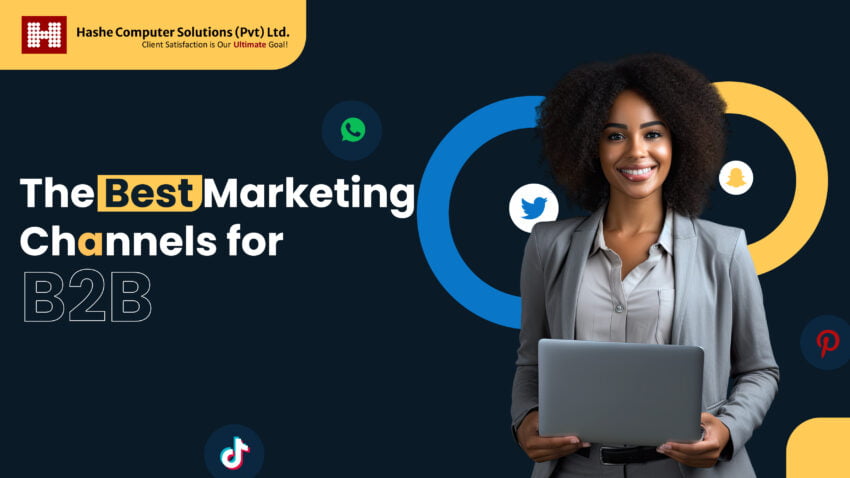
The advertising strategies selected for any organization must demonstrate a thorough awareness of the demands and preferences of the target market. Although there are many B2B marketing channels accessible for lead generation, some may be far more successful for your specific business.
Digital marketing techniques are multiplying quickly and gaining popularity when it comes to generating high-quality leads. You may determine which channels are most effective for maximizing conversions by testing several ones, and you can then adjust your B2B marketing efforts appropriately.
Every year, as B2B marketing trends shift, the most effective B2B marketing channels also vary. It necessitates a comprehensive strategy to take advantage of all potential combinations. To increase visibility and drive traffic, marketers must develop an integrated strategy that involves a range of digital channels, such as blogs, email marketing, webinars, search engine optimization (SEO), content creation, and social media promotion, among many others.
Such all-encompassing strategies should aim to reach audiences in as many locations as possible, making lead generation unavoidable (both online and offline) and facilitating clients’ easy discovery of you.
Let’s look at the best marketing channels for B2B.
1. Email Marketing
Email is one of the most significant platforms for business-to-business marketers to reach their target demographic. It is an ideal tool for specifically targeting potential customers, boosting its effectiveness. It is essential to properly organize your email campaigns, placing segmentation and personalization at the core of your approach.
It enables you to send customized messages that are more likely to engage with the right individuals. For instance, if you customize emails based on specific consumer behaviors or previous comments, you can employ segmentation by industry or buyer profiles and significantly increase your open rate and click-through rate.
2. Thought Leadership Blog Posts
Search Engine Optimization (SEO) is a powerful tool for generating leads and marketing your company, but it takes time and work to see results. Thought Leadership SEO blends thought leadership and SEO to help your company establish itself and enhance organic search traffic. You may build a steady stream of prospects by consistently uploading relevant material. However, remember that this takes time, and hurrying the process will not result in success.
Thought leadership blog posts are beneficial to SEO since they promote the writer or firm as an industry authority. Thought leaders can establish a dedicated following and acquire backlinks from other credible websites by giving relevant insights and thoughts on industry trends and concerns. That, in turn, boosts the company’s website’s trustworthiness and enhances its search engine rating. Furthermore, thought leadership postings frequently include less competitive long-tail keywords, allowing the website to rank better in search results.
Overall, thought leadership blog postings can boost a website’s SEO by boosting authority, gaining backlinks, and targeting specific keywords. Companies may analyze the efficiency of these initiatives and track SEO development over time using tools like Google Analytics.
3. Pay-Per-Click (PPC) Advertising
Pay-per-click (PPC) advertising is a type of digital marketing where you pay for each click a person makes on your ad rather than just showing it to them. Instead of creating indifferent impressions like other forms of ad display, advertisers only get charged when a potential buyer actively expresses interest in their products or service.
Search Engine Marketing (SEM) is a type of paid advertising that aims to promote websites by making them more visible on popular search engines like Google. It can be expensive, especially for small and medium-sized enterprises, but it allows them to promote their brand and provide a positive first impression.
Though this form of advertising might be costly based on the target market and competitors paying for comparable keywords or placement, the tactical approach of spending in targeted clicks rather than thousands of impressions sometimes leads to better outcomes.
4. LinkedIn Advertising
LinkedIn always tops the list when it comes to using social media networks in professional settings. It is designed primarily for professionals and business leaders, so it caters to a demographic that is constantly eager to connect with higher-level information.
Since LinkedIn is more specialized than other networks, users can more easily target niche demographics and use cases. However, because LinkedIn advertising can be so costly, particularly for smaller firms, it can be challenging to justify the costs. You need solid prospect data with highly successful thought leadership content – especially created for LinkedIn’s target audiences – to maximize the return on such an investment. When using LinkedIn as part of your entire digital strategy, ensuring all those elements are in place beforehand can help save time and costs.
5. LinkedIn Content Marketing
LinkedIn is an effective business tool of great value to companies. Its goal of assisting professionals in finding like-minded individuals and advancing their professions has produced a platform that promotes teamwork, speeds up learning, and provides valuable networking opportunities. Companies can target potential customers using a variety of precise criteria, including job functions, seniority level, and interests, thanks to the enormous volume of user data.
Furthermore, businesses may broaden their audience and boost the exposure of their social media marketing campaigns by utilizing content marketing options that include videos or photographs. Using all of LinkedIn’s features will enable you to produce visually appealing content that connects with B2B buyers at the appropriate stage of their buying process.
6. Account-Based Marketing (ABM)
An innovative marketing technique, account-based marketing (ABM), merges channels to produce the ultimate omnichannel approach. ABM focuses on targeted accounts to convert them into customers rather than casting a wide net like traditional lead generation. Targeting ideal clients comes first, followed by introducing tailored marketing initiatives to maintain and convert them. The usual lead generation funnel flips in this method, enabling collaboration between marketing and sales teams to discover leads with the highest conversion potential.
7. Webinars and LinkedIn Live
Webinars give an engaging and instructive platform for anyone who wants to learn more about a specific topic. They are held in real-time, allowing the audience to ask questions via live chat if they arrive during the presentation. It gives others who might not be able to attend the event in person simple access by offering a video that can still be helpful. Presenters can demonstrate their knowledge without being concerned about having an edited version of themselves.
Unlike webinars, which are frequently pre-recorded and don’t allow for live interaction, LinkedIn Live enables presenters to establish a more genuine and personal connection with their audience. Additionally, LinkedIn Live is created exclusively for business networking and content connected to business, giving it the perfect venue for thought leaders, business professionals, and industry experts to share their expertise and insights with a larger audience.
8. Public Relations
Public relations (PR) is a vital component of any successful company. It entails actively managing a company’s reputation and image to keep it in good standing with the media, key opinion leaders in the market, and prospective clients. Companies can develop a positive public opinion for their products or services by adopting PR strategies, including upholding positive relationships, handling crises responsibly, and fostering positive perceptions among stakeholders.
Public relations also play a significant role in B2B marketing by informing potential customers, trade journals, and business partners of important news regarding their products or services. Businesses that create and disseminate expert views on pertinent industry issues also have a better chance of gaining credibility and becoming thought leaders among their peers. PR methods can be an excellent way to raise brand recognition and produce new leads when used as part of a larger B2B marketing strategy.
Wrapping Up!
The company’s goals and marketing budget will determine the appropriate B2B marketing channels. Public relations, email marketing, and social media are all helpful strategies for reaching potential clients and generating leads. When choosing the best channel for your company, it’s crucial to weigh the benefits and drawbacks of each.
The best B2B marketing channels ultimately depend on your target market and sector. However, you may develop a thorough approach that targets your ideal clients and aids in expanding your organization by combining email marketing, social media, content marketing, and more. Don’t be hesitant to experiment and try various strategies, and always remember to keep track of and analyze your outcomes to improve your marketing efforts.
Are you looking for the best IT providers for your IT projects? Look no further than Hashe! Hashe Computer Solutions is a leading IT solutions provider that offers world-class software, mobile application, web development, and digital marketing services. Contact us for the best web design solutions!
Keep following us for more tech news! Check out our Social Media Pages
Was this helpful?
Last Modified: June 25, 2024 at 10:12 am
110 views











